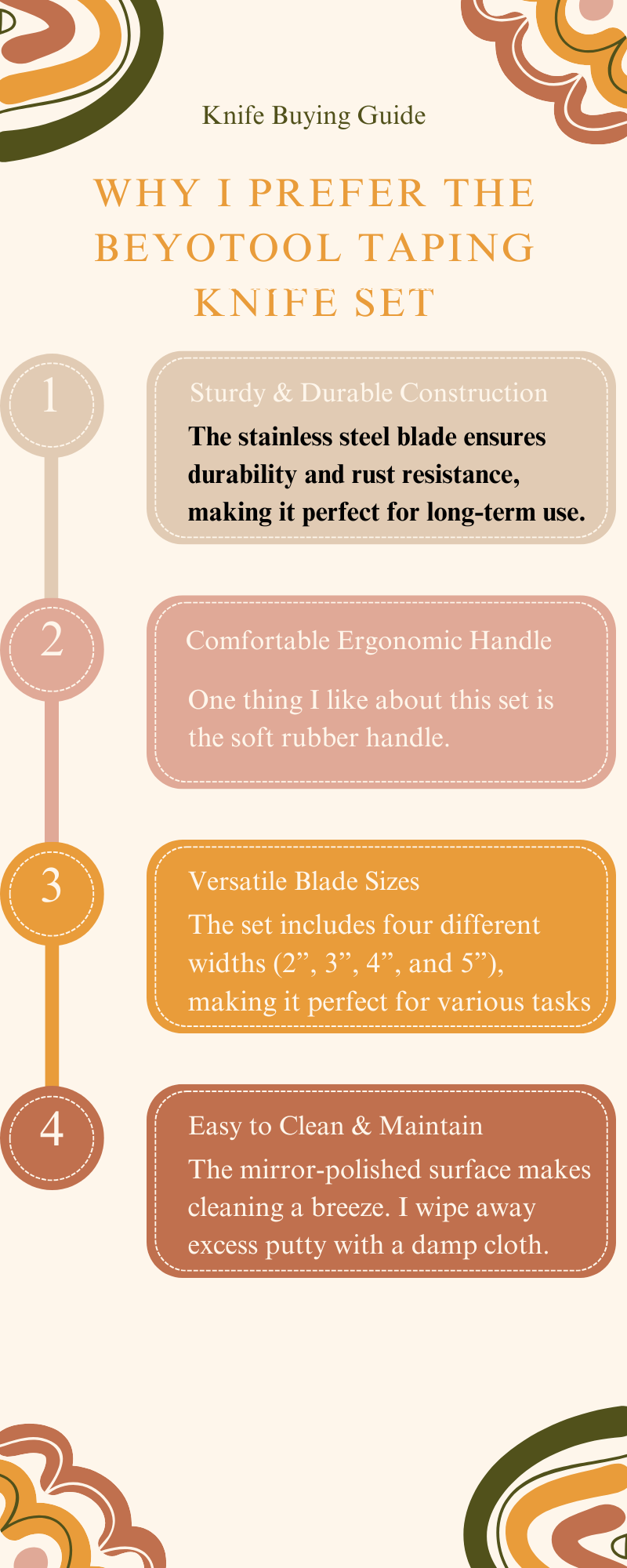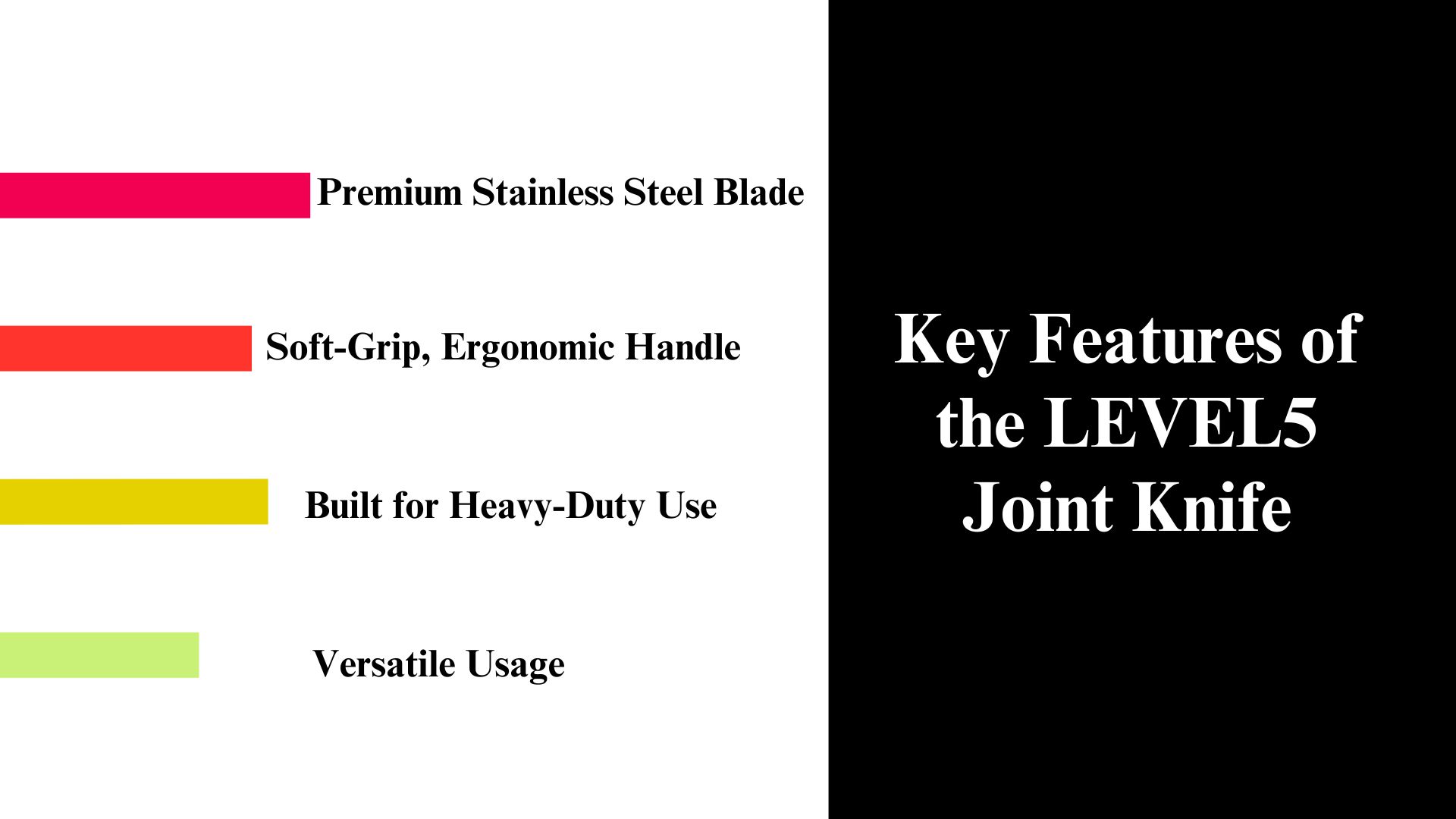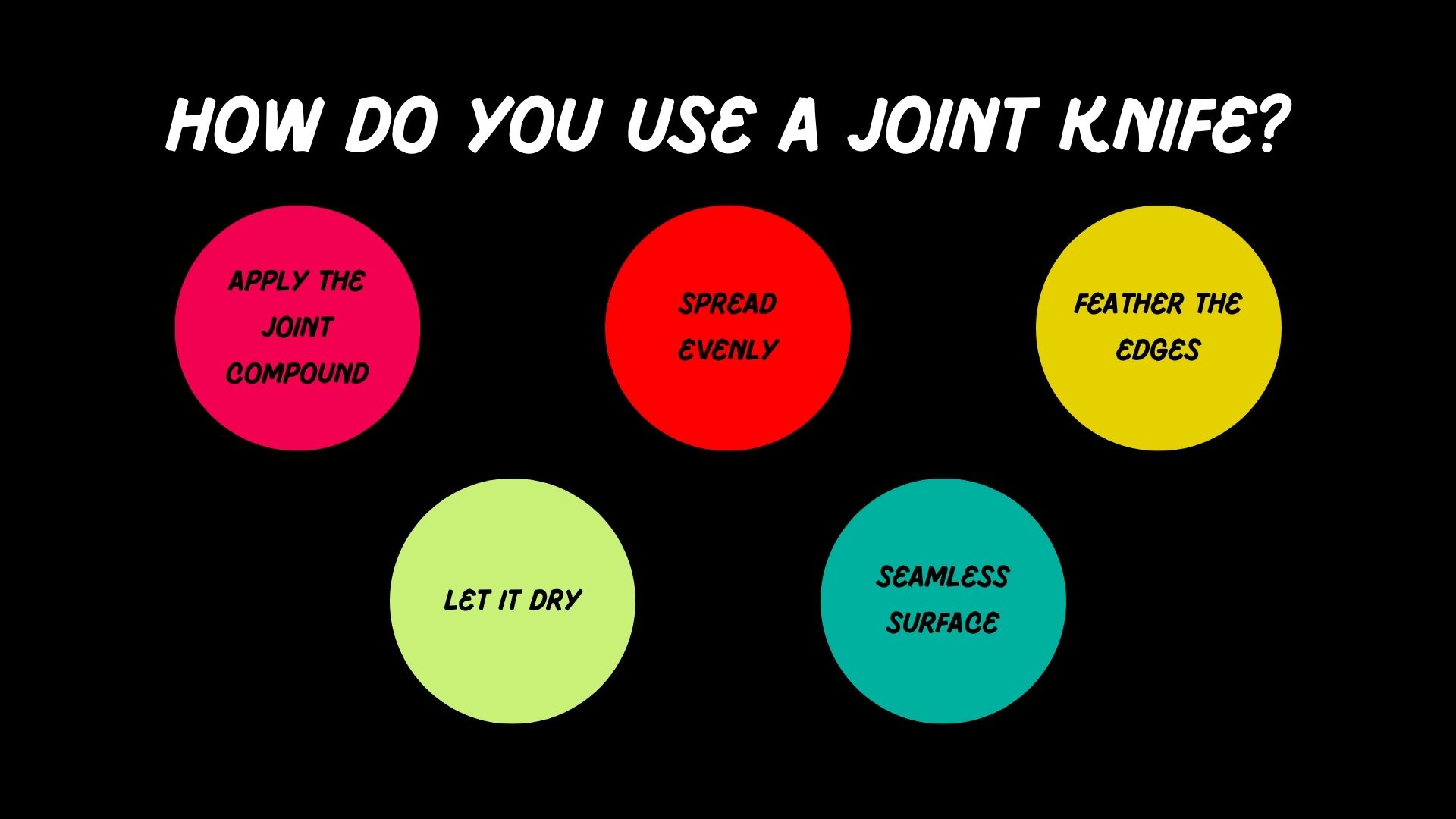Taping Knife vs Joint Knife: Which Tool Is Right for Your
Regarding home improvement, I always rely on the taping knife. Whether repairing drywall, applying putty, or smoothing out plaster, this simple yet effective tool makes all the difference. If you’ve ever struggled with uneven surfaces or messy finishes, you need a taping knife to your toolbox.
What is a Taping Knife?
A taping knife is a wide-bladed tool for spreading, smoothing, and levelling materials like drywall compounds, putty, plaster, and adhesives. It’s a must-have for:
- Drywall finishing – Applying and smoothing joint compound over seams.
- Plastering – Spreading and levelling plaster for a smooth wall finish.
- Scraping & removing materials – Perfect for wallpaper removal, old paint, and sticky residues.
Unlike a putty knife, which has a smaller blade and is ideal for filling small holes or cracks, a taping knife has a wider blade (typically 4 to 12 inches) and can quickly cover larger areas.
Comparison Taping Knife
| Feature | Taping Knife |
| Primary Use | Applying tape and joint compound to seams |
| Blade Flexibility | More flexible for smoother tape application |
| Blade Size | Larger, usually 8-10 inches |
| Handle Design | Longer for better reach and control |
| Best For | Taping seams, applying compound |
Why I Prefer the Beyotool Taping Knife Set

After trying multiple brands, I found that the Beyotool 4-piece Spackle Knife Set is among the best. Here’s why:
1. Sturdy & Durable Construction
The stainless steel blade ensures durability and resistance to rust, making it perfect for long-term use. Unlike carbon steel, which can corrode over time, the Beyotool taping knife stays sharp and rust-free.
2. Comfortable Ergonomic Handle
One thing I love about this set is the soft rubber handle. The ergonomic grip prevents hand fatigue, especially during long projects. If you’ve ever used a cheap scraper that made your hand sore, you’ll appreciate the difference a well-designed handle makes.
3. Versatile Blade Sizes
The set includes four different widths (2”, 3”, 4”, and 5”), making it perfect for various tasks:
- 2” blade – Ideal for applying adhesives and drywall tape.
- 3” blade – Best for filling small cracks and nail holes.
- 4” & 5” blades – Perfect for smoothing large areas and applying putty or plaster.
4. Easy to Clean & Maintain
🔪 Knife Maintenance Calculator
The mirror-polished surface makes cleaning a breeze. I wipe off excess putty with a damp cloth, and the blade looks as good as new.
Related Post:
How I Use a Taping Knife for DIY Projects
Here’s how I make the most of my taping knife for different home improvement tasks:
1. Repairing Drywall Cracks
I start by applying a thin layer of joint compound over the crack using my 3” taping knife. Once it dries, I sand it lightly and apply a second coat with the 5” blade for a seamless finish.
2. Removing Wallpaper & Old Paint
The stainless steel blade is strong enough to scrape off old wallpaper and paint. I use the 4” knife to lift peeling edges gently, then work across the surface.
3. Applying Plaster & Cement
I use the 5” taping knife to spread and smooth out plaster when working with larger surfaces. The flexible blade helps me achieve a professional-looking finish without streaks.
4. Filling Holes & Gaps
F grab the 2” blade for smaller repairs to fill nail holes and minor wall imperfections. A quick pass with the 3” knife smooths everything out perfectly.
Why This Taping Knife Set is a Must-Have
With over 3,000 positive reviews and an Amazon’s Choice badge, the Beyotool 4Pcs Spackle Knife Set is a favourite among DIYers and professionals. Plus, it’s affordable to any toolkit at just $5.97 (40% off).
I highly recommend this set if you’re looking for a high-quality taping knife that can handle everything from drywall repairs to wallpaper removal,
Where to Buy
Beyotool Taping Knife Set is discounted on Amazon. Over 9,000 sets were sold last month, proving this is a go-to tool for home improvement enthusiasts.
| Pros | Cons |
| 1. High-Quality Blade – Rust-resistant stainless steel, durable one-piece design. | 1. Not for Heavy-Duty Work – Not ideal for large-scale construction or thick plaster. |
| 2. Ergonomic Handle – Soft rubber grip reduces fatigue, non-slip for better control. | 2. Blade Too Flexible for Some – Great for smooth finishes but not harsh scraping. |
| 3. Versatile Sizes – 4-piece set (2”, 3”, 4”, 5”) covers various tasks. | 3. Handle Durability – Rubber may wear down; wood or plastic may last longer. |
| 4. Easy to Clean – Polished surface prevents sticking; wipes clean easily. | 4. Limited Size Range – Largest blade is 5”; bigger jobs may need 10” or 12” knives. |
| 5. Budget-Friendly – $5.97 (40% off), 3,000+ positive reviews, Amazon Choice. |
Final Verdict: Is It Worth Buying?
YES, if you’re seeking an affordable, high-quality taping knife set for DIY projects, drywall repairs, and home improvement tasks.
No, you need heavy-duty tools for professional construction work or extra-large drywall knives.
At $5.97 (a limited-time deal), the Beyotool Taping Knife Set is one of the best budget-friendly options on the market. With four sizes, a comfortable grip, and a rust-resistant blade, it’s a must-have for anyone tackling small—to medium-sized home repairs.
Taping knife vs joint knife– A Professional’s Choice
A high-quality joint knife is essential if you’re serious about drywall finishing. The LEVEL5 6” Soft-Grip Stainless Steel Drywall Joint Knife is a professional-grade tool designed to smooth joint compound, plaster, and putty application. With nearly 20 years of professional input behind its design, this Amazon’s Choice product has earned 4.8 out of 5 stars from over 2,000+ satisfied customers.
In this review, I’ll cover its features, benefits, pros and cons, and whether it’s worth adding to your toolbox.
Comparison: Taping Knife vs Joint Knife
| Feature | Joint Knife |
| Blade Material | Stainless steel, sometimes with a hollow grind |
| Handle Material | Soft grip, nylon, or composite for durability |
| Durability | Designed for long-term use with robust construction |
| Flexibility | Moderate to low flexibility for precision |
| Comfort | Ergonomic design for reducing hand fatigue |
Key Features of the LEVEL5 Joint Knife

1. Premium Stainless Steel Blade
The hollow-ground blade is made from high-quality stainless steel, which makes it rust-resistant, durable, and flexible. Unlike cheaper knives, this one has a precision flex point midway up the blade (instead of near the handle), which provides better control and a smoother finish.
2. Soft-Grip, Ergonomic Handle
Comfort matters when working long hours. The soft-grip handle is designed for minimal hand fatigue, even during extended use. It provides a secure grip, ensuring stability while spreading mud, taping drywall seams, or smoothing surfaces.
3. Built for Heavy-Duty Use
This joint knife is full tang, meaning the blade extends through the entire handle, making it sturdier than partial-tang tools. The double-riveted construction ensures durability, preventing blade detachment over time.
4. Versatile Usage
The LEVEL5 6” joint knife is perfect for:
- Applying and smoothing joint compound on drywall.
- Filling cracks and holes with putty or plaster.
- Removing excess mud, paint, or debris.
- Setting and cutting drywall tape.
- General home improvement tasks require a smooth finish.
5. Easy to Clean & Maintain
This knife is easy to clean thanks to its polished stainless steel finish. Just wipe off excess material with a damp cloth, and it’s ready for the next job.
Alternatives You May Consider:
- LEVEL5 4” or 8” Joint Knife – For smaller or larger jobs.
- DEWALT Stainless Steel Joint Knife – Another quality option.
- Hyde Tools Pro Stainless Steel Knife – A more budget-friendly alternative.
Need help choosing the right joint knife for your project? Drop a comment, and I’ll guide you!
Pros & Cons of the LEVEL5 6” Joint Knife
| Pros | Cons |
| Professional-Grade – Designed with input from drywall pros. | Higher Price – Costs more than essential joint knives. |
| Durable Blade – Rust-resistant stainless steel for longevity. | Not for Hard Scraping – A putty knife is better for rigid materials. |
| Soft-Grip Handle – Provides superior comfort during long use. | |
| Hollow-Ground Blade – Balanced flex for better control. | |
| Full Tang, Double-Riveted – Stronger than standard knives. | |
| Easy to Clean – Polished finish prevents material buildup. |
Who Should Buy the Level 5 6” Joint Knife?
- This pro-grade tool is ideal for
- Drywall professionals need a reliable joint knife for daily use.
- DIYers & home renovators who want a high-quality tool for patching walls.
- Contractors & painters looking for a comfortable, long-lasting knife.
Final Verdict – Is It Worth It?
Absolutely! The LEVEL5 6” Soft-Grip Joint Knife is a top-tier tool for smooth, effortless drywall finishing. It’s well-built, durable, and comfortable, making it an excellent investment for professionals and DIY enthusiasts.
⭐ Rating: 4.8/5 (Highly Recommended)
Where to Buy?
The LEVEL5 6” Joint Knife is available on Amazon for $15.99. Given its durability and pro-level design, it’s well worth the price.
1. What is a Joint Knife Used For?
A joint knife is a wide-blade tool designed for applying and smoothing joint compounds (mud) on drywall seams. It helps create a seamless finish when installing or repairing drywall. Other uses include:
- Filling nail holes and cracks in walls.
- Spreading plaster, putty, or spackle.
- Smoothing adhesive or caulk for a professional finish.
2. What is the Difference Between a Joint and a Putty Knife?
While both tools look similar, they have distinct differences:
- Joint Knife: Typically more expansive (4” to 12”), designed for applying drywall joint compound.
- Putty Knife: This narrow knife (1” to 3”) is mainly used for applying putty or scraping old paint, glue, or wallpaper.
A joint knife is better for large, smooth applications, whereas a putty knife is great for minor repairs and detail work.
3. What Size Joint Knife Should I Use?
The best size depends on the task:
- 4” – 6” → Ideal for patching holes or minor repairs.
- 8” – 10” → Used for spreading joint compound over seams.
- 12” – 14” → Best for final smoothing and feathering drywall mud.
For a professional drywall finish, many workers use a 6” knife for applying compound and a 12” knife for smoothing.
4. How Do You Use a Joint Knife?

To achieve a smooth drywall finish, follow these steps:
- Apply the joint compound with the knife at a 45-degree angle.
- Spread evenly over the seam or hole.
- Feather the edges by increasing pressure on the outer edges.
- Let it dry, then sand lightly for a smooth finish.
- Repeat as needed for a perfect, seamless surface.
5. What is the Best Joint Knife Material?
Most professional joint knives are made of the following:
- Stainless Steel → Rust-resistant, flexible, and durable (best for long-term use).
- Carbon Steel → Strong but prone to rust if not maintained properly.
- Plastic → Cheap and disposable but not as durable.
A stainless steel joint knife with an ergonomic handle is the best choice for longevity and performance.
6. Can a Joint Knife Be Used for Scraping?
Yes, but with limitations. While a joint knife can remove loose drywall mud or soft materials, it’s not as strong as a stiff putty knife for scraping hardened paint, glue, or debris.
A stiffer blade, like a putty knife or paint scrape, works better for heavy scraping tasks.
Final Thoughts
A joint knife is essential for drywall work, plaster application, and home repairs. Whether you’re a DIYer or a professional contractor, choosing the right size and material can significantly improve your results.
Taping Knife vs. Joint Knife – What’s the Difference?
Working with drywall requires a smooth, professional finish. The taping knife and joint knife are two of the most common tools used in drywall finishing. While they may look similar, they serve different purposes.
In this guide, I’ll break down the key differences, uses, pros, and cons of each so you can choose the best tool for your job.
Key Features of a Taping Knife:
- Blade Width: Typically 6″ to 14″ wide (wider than a joint knife).
- Blade Material: Made of stainless steel or blue steel for flexibility.
- Handle Type: A standard grip or an extended handle for better reach.
- Best For: Applying and feathering joint compound over seams and corners.
Key Features of a Joint Knife:
- Blade Width: Usually between 1.5″ and 6″ wide (narrower than a taping knife).
- Blade Material: Made of stainless steel, carbon steel, or plastic.
- Handle Type: Soft-grip or hard plastic for comfort.
- Best For: Filling holes, taping small joints, and scraping surfaces.
3. Taping Knife vs. Joint Knife – Key Differences
| Feature | Taping Knife | Joint Knife |
| Blade Width | 6″ – 14″ (wide) | 1.5″ – 6″ (narrow) |
| Purpose | Spreading & feathering joint compound | Patching, taping, and scraping |
| Best For | Large drywall seams & final coating | Minor repairs, filling holes, and removing residue |
| Flexibility | Moderate to high | High |
| Ease of Use | Requires some skill | Easier to control |
| Coverage | Covers large areas quickly | Slower for large surfaces |
Which One Should You Use?
Use a Taping Knife if:
✔ You’re applying joint compound over large drywall seams.
✔ You need a smooth, even finish before painting.
✔ You’re working on a big drywall installation project.
Use a Joint Knife if:
✔ You need to fill small holes, cracks, or nail indentations.
✔ You want a multi-purpose tool for scraping and patching.
✔ You’re working in tight spaces or doing minor repairs.
Final Verdict: Which One Is Better?
Both tools are essential for drywall finishing. You likely need complete if you’re doing a complete drywall installation. The taping knife is better for large areas, while the joint knife is best for small patches and touch-ups.
You should start with a joint knife if you’re a beginner or working on a DIY home project. Investing in a quality taping knife will save you time and effort if you plan to mud and tape an entire room.
💡 Pro Tip: Many professionals use a 6″ joint knife for initial application and then switch to a 12″ taping knife for feathering and smoothing.


